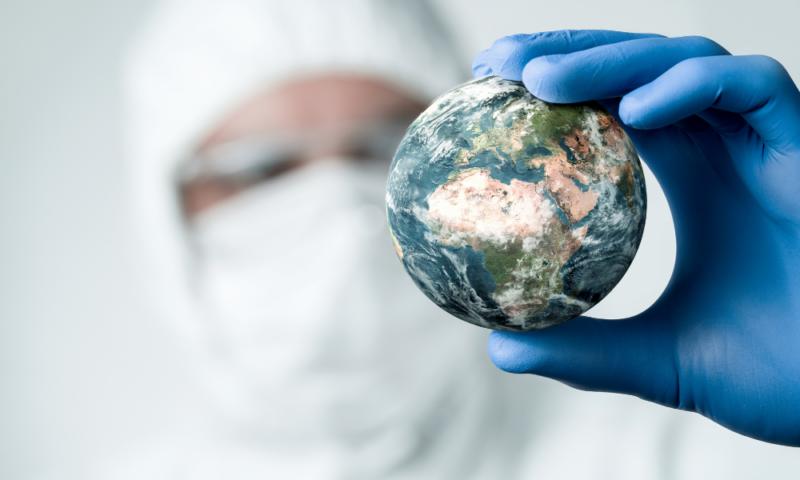May Message from the Directors: The End of a Pandemic
director's message Heading link

As the COVID-19 public health emergency officially ended on May 11, 2023, we reflected on how the pandemic arrived at UI Health and the impact our response to this global challenge had locally and among the greater community.
While the first case reported in Wuhan, China of what was then called a novel coronavirus occurred in December 2019, it was not until late January 2020 that the first such case was seen in the United States. The Centers for Disease Control was tracking the outbreak from the start and identified a case in Washington state in a traveler from China. They sent daily bulletins with clinical descriptions of the disease as well as precautions, although little was known about the route of transmission or pathogenesis.
That same week, UI Health’s division of infectious disease had an emergency meeting to develop plans should the virus arrive in Chicago. Physicians took turns manning the coronavirus pager to triage incoming calls from the other clinical services and provide guidance. Once the second case of what came to be known as COVID-19 was seen here in Chicago, it was clear more would follow, although no one knew the extent of what was coming.
Over the next weeks, the number of new patients became a torrent, and the hospital was stressed to its limits. There was not enough PPE to meet staff needs, patients and healthcare providers feared for their lives, three nurses died, and doctors, nurses and hospital staff learned how to care for this new disease on the fly. Faculty in infectious diseases joined a work group to address the rising number of cases in homeless shelters. The Illinois Department of Public Health (IDPH) contracted with us to investigate cases in congregate living centers, like nursing homes, where we found that identifying one case eventually meant over 50% of the occupants were also infected, and the mortality was high.
Hospital incident command met daily to update leadership and develop management plans, such as building out the emergency department with tents, staffing, and converting all ICUs into COVID units. The campus went into lock down and all clinical research was halted. Well, not quite all research.
The first few months of 2020 were spent looking for treatments, reducing the spread of infection through use of PPE and isolation, contact tracing and quarantine. Calls began coming to NIH-funded clinical research networks to participate in drug trials that may be beneficial for this new infection. We studied remdesivir for hospitalized patients. It was not long before research sites were contacted to participate in the planning for eventual vaccine trials.
The Coronavirus Prevention Network was created from clinical sites participating in multiple other NIH funded networks as part of the federal government’s Operation Warp Speed. The first trial with the Moderna vaccine began in July 2020, a massive effort to enroll 30,000 participants in about 2 months. At UI Health, this trial was conducted at Project WISH and the CCTS’s Clinical Research Center. The effort paid off, with the first vaccines available that December. UI Health researchers also worked on the Janssen vaccine and two monoclonal antibody studies. Later, as new viral variants emerged, we continued to work on vaccine trials in pregnant women as well as testing variant vaccines, some of which are still underway.
Other research endeavors focused on inpatient and outpatient treatments, pathogenesis, community engagement- particularly directed at improved vaccine uptake– and vaccine distribution throughout the city. The CCTS supported new research to develop better diagnostics and dectection devices for COVID-19, examine virus-related health disparities, explore the pandemic’s social and mental health impact on the citizens of Chicago and more.
The Chicago Department of Health and IDPH both called upon UIC for contact tracing and community-based vaccine distribution. Many departments worked on various aspects of the disease, all the while continuing to treat Long COVID. Research on post-acute sequelae SARS-CoV-2 infection (PASC) began in earnest with funding of a large multisite study, ILLInet Recover, headed by UIC’s Dr. Jerry Krishnan.
We have all watched the severity and incidence of infection decline as community immunity gradually increased due to vaccination and infection. COVID-19 remains a reportable disease, but regular reports of disease activity will no longer be made. Access to vaccines and treatment will still be free as long as existing government supplies last, but after that, the costs will be passed on to consumers. No more free tests, either. It is not clear if congress will support additional funding to develop next generation vaccines, and we don’t know if COVID-19 will return again in another surge. For now, we can enjoy a gradual return to a level of freedom we have missed during the pandemic. But society is forever changed as a result of the events that began in December 2019.